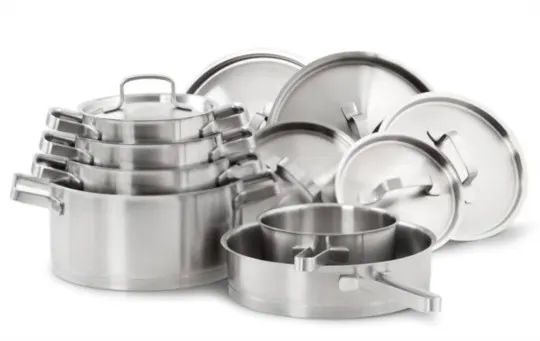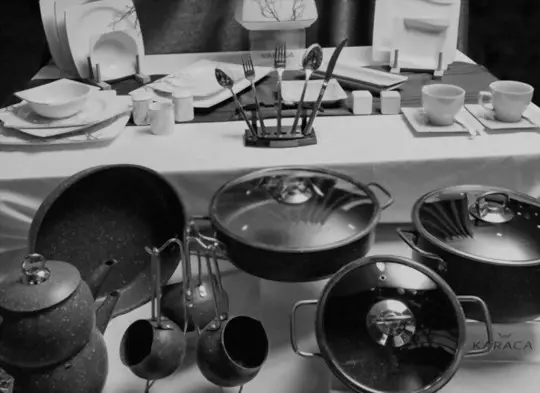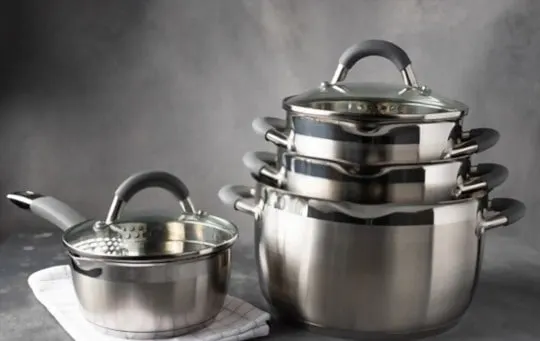Ever stood in a kitchen and wondered, “Is that pan made of porcelain steel or stainless steel?” We’ve been there.
It’s a kitchen showdown between the shiny allure of stainless steel and the classic charm of porcelain steel. Both have their fan clubs and critics.
Stainless steel, the popular kid, known for its resilience and sleek look, makes cleaning up less of a chore. Porcelain steel, on the other hand, holds memories of grandma’s kitchen; it’s like the comfort food of cookware, warming our hearts and homes.
Why do we care? Because every meal we cook, every pot we scrub, tells the story of us. This isn’t just about pots and pans; it’s a battle for the soul of our kitchens.
We’ve got tales to tell and meals to make. Choosing the right contender matters.
What is Porcelain Steel?

Porcelain steel is a type of coated steel commonly used in making household appliances and fixtures.
The steel is coated with porcelain enamel, a material made from powdered glass fused to the surface of metal under high temperatures.
Porcelain enamel gives the steel a smooth and glossy finish that is highly durable and resists stains, scratches, and rust.
Because of these features, porcelain steel appliances are easy to clean and maintain, making them a popular choice among homeowners.
In addition to being durable and easy to clean, porcelain steel also has excellent heat-resistance properties.
This makes it suitable for use in kitchen appliances such as ovens and grills, where high temperatures can cause warping or damage over time.
The cost of manufacturing porcelain steel is also lower than that of stainless steel, which makes it a more affordable option for consumers looking for quality yet cost-effective household items.
Overall, Porcelain Steel is an ideal option for those on a tight budget but who still want quality products that will last long without requiring extensive maintenance.
Its resistance to heat, corrosion and ease of cleaning undoubtedly make it stand out compared to other materials on the market today.
What is Stainless Steel?

Stainless Steel is a type of alloy that contains a minimum of 10.
5% chromium by mass.
This composition creates its corrosion-resistant property, making it a popular material for various applications in construction, food processing, and medical equipment.
It has a lustrous appearance and can withstand high temperatures, making it an excellent choice for cooking utensils.
Stainless steel is durable, strong, and easy to clean due to its non-porous surface.
When choosing stainless steel products, one should be aware of the different grades available as they vary in terms of strength, resistance to chemicals or heat and some might even be magnetic.
This makes it important to determine what grade would be appropriate depending on the intended use of the product.
Some common types include austenitic stainless steel, ferritic stainless steel, and martensitic stainless steel.
It’s worth noting that while all three types are made from chrome-iron alloys with varying amounts of other metals mixed in; they have distinct characteristics – such as hardness or brittleness – that affect their performance under different conditions.
Therefore, knowing your materials and understanding their limitations will result in better decision-making when it comes to selecting between porcelain steel or stainless steel products.
Differences Between Porcelain Steel and Stainless Steel

Porcelain steel and stainless steel may seem similar, but they have notable differences.
Porcelain steel is a type of sheet steel coated with porcelain enamel, while stainless steel is an alloy made from a combination of metals such as chromium, nickel, and iron.
Composition and Manufacturing
The process of creating Porcelain Steel and Stainless Steel involves specific methods of composition and manufacturing.
Porcelain Steel is made by mixing a steel base with a porcelain enamel coating, which is then fired at high temperatures to bond the two materials together.
On the other hand, Stainless Steel is created by combining iron with varying amounts of nickel, chromium, and other elements, giving it its unique properties like resistance to corrosion and staining.
The manufacturing process for Stainless Steel involves melting the raw materials in a furnace, combining them into an alloy, and then forming them into different shapes.
Interestingly, Porcelain Steel is known for its ability to resist acids and harsh chemicals better than any other material.
It also has excellent scratch-resistant properties that make it highly durable over time.
Stainless Steel offers benefits such as high heat resistance levels, which allow it to withstand extreme temperatures without deforming or warping.
Additionally, this material’s hygienic qualities make it perfect for use in environments where cleanliness is paramount.
Overall, both materials have their unique properties that make them suitable for various applications.
The choice between Porcelain and Stainless Steel ultimately depends on the specific requirements of your project or application.
By understanding their composition and manufacturing processes can help you choose the ideal material based on your needs.
Durability and Resistance to Corrosion
Porcelain steel and stainless steel differ significantly in terms of their durability and resistance to corrosion.
While both materials possess high tensile strength, porcelain steel is more resistant to chipping, peeling and fading compared to stainless steel.
The latter is susceptible to rusting and staining when exposed to moisture or saltwater environments.
However, stainless steel can withstand extreme weather conditions and abrasions more efficiently than porcelain steel due to its higher hardness level.
Moreover, the longevity of both materials depends on their maintenance requirements.
For instance, regular cleaning and polishing are necessary for maintaining the appearance of stainless steel since it tends to attract fingerprints and smudges easily.
At the same time, porcelain plates require careful handling as they may crack under sudden impacts.
Nevertheless, porcelain-enameled grates have thicker coatings that provide a long-lasting non-stick surface that can withstand high temperatures.
In summary, while both materials offer excellent durability and resistance to wear and tear, porcelain steel stands out for its superior chip-resistance whereas stainless steel excels in resisting rust and stains but is less resistant to chipping finish.
Ultimately, the choice of material depends on factors such as usage patterns, location, aesthetics preferences as well as performance needs.
Heat Conductivity
Porcelain steel and stainless steel are two different materials used for cooking appliances.
Porcelain steel has lower heat conductivity compared to stainless steel, but it is more durable and less prone to scratches.
On the other hand, stainless steel has higher heat conductivity, making it suitable for cooking at high temperatures.
Moreover, porcelain steel may chip under high impact but it is rust-resistant while stainless steel can be prone to rusting in certain conditions.
Both materials have their advantages and disadvantages when it comes to their heat conductivity and overall performance in cooking appliances.
Appearance and Aesthetic Appeal
The appearance and aesthetic appeal of porcelain steel and stainless steel can significantly affect your decision when choosing between the two.
The former exudes a smooth, polished look with high-gloss finishes that provide an upscale visual appeal.
On the other hand, stainless steel has a matte, brushed finish that gives it an industrial vibe.
Both materials offer versatile design options, allowing you to match them with different styles and palettes.
When it comes to longevity and durability, porcelain steel wins over stainless steel due to its unique composition.
The porcelain layer provides an extra layer of protection against corrosion, rust, and scratches that can significantly damage your appliance over time.
Also, porcelain enamel prevents discoloration from heat exposure and grease stains that can make your appliance appear shabby.
In terms of maintenance requirements, porcelain-enameled surfaces are easier to clean than their stainless-steel counterparts.
A simple wipe down with soap and water is enough to remove most stains without leaving watermarks or streaks behind.
Stainless steel needs specific cleaning agents that prevent water spots while giving it a polished sheen.
Overall, both materials have their benefits and disadvantages in terms of appearance and upkeep requirements.
Choose your ideal material based on the features you value most in your kitchen appliances – whether it’s a smooth glossy finish or a sturdy matte appearance best suited for rough usage.
Similarities Between Porcelain Steel and Stainless Steel

Porcelain steel and stainless steel share some similarities, which are essential in determining what makes one suitable over the other.
Both materials are popularly used in kitchen appliances such as refrigerators, ovens, and dishwashers.
They both possess rust-resistant qualities that increase their durability, lifespan, and ability to withstand scratches or dents.
Porcelain steel’s glossy finish is also similar to the look of stainless steel, giving it an aesthetic edge when used in interior design projects.
In terms of material production process, Porcelain Steel and Stainless Steel are both manufactured with heat under high pressure to create hard surfaces that can resist stains and corrosion.
Porcelain enamel is a glass coating fused to heavy gauge steel, while stainless steel is an alloy made from iron mixed with other metals like nickel or chromium.
One unique feature of porcelain steel is its insulating properties.
When porcelain enamel coats the underlying metal surface of this material, it creates a thermal barrier that slows down the transfer of heat or cold energy.
This feature makes porcelain enamel suitable for use in constructing fireproof safes and high-performance cookware.
Overall, both materials have their defining attributes that make them suitable for different applications- depending on factors such as budgetary considerations or specific properties needed for successful performance.
Common Applications and Uses
Porcelain steel and Stainless steel have their own common applications and functions.
Porcelain steel is frequently used for whiteboards, bathtub surfaces, and enamel appliances due to its resistance to abrasions, stains, and chemicals.
While stainless steel is commonly employed in industries such as food service, medical devices, automotive parts, construction works and home appliances because of its strength and durability.
The distinctive features of both materials make them suitable for a wide range of uses in different fields.
In comparison to porcelain steel, stainless steel has exceptional qualities that make it more versatile.
Stainless steel’s high resistance to heat and corrosion makes it the ideal choice for enduring harsh weather conditions or chemical reactions.
This material is frequently used in applications that require both hygiene and flexibility, allowing it to be used in hospitals, clinics or gyms where sanitation is essential.
To summarize, while both materials have their respective uses in various applications; porcelain steel performs admirably for specialized functions like whiteboards or enamel equipment; whereas stainless steel has dominant qualities that make it an excellent choice for a variety of industries such as construction work or medical equipment manufacturing.
Understanding the differences between these two types of steels will enable individuals to select the proper material needed based on particular needs.
Considerations for Choosing Between Porcelain Steel and Stainless Steel
When selecting between porcelain steel and stainless steel, there are various factors to take into account.
Porcelain steel is a coated metal that offers added durability, scratch resistance, and moisture resistance.
Although it can be more affordable, it may chip or crack if dropped or struck with a hard object.
Stainless steel is a corrosion-resistant alloy that is stain-resistant and has excellent heat tolerance.
It’s easy to clean but may be pricier than porcelain-coated options.
An important consideration when deciding between these two materials is the intended use of the product.
For example, porcelain-coated grill grates are ideal for lower-temperature cooking since they take longer to heat up and hold onto less heat than their stainless steel counterparts.
However, stainless steel grates provide better flavor transfer and searing abilities.
Additionally, the maintenance requirements of each material should also be considered.
Porcelain-coated products can wear down over time; as such, abrasive cleaning tools must be avoided to preserve their finish.
On the other hand, stainless steel requires regular polishing to maintain its luster.
Conclusion
The difference between porcelain steel and stainless steel cookware is crucial to consider when purchasing kitchen equipment.
Porcelain has a smoother surface, while stainless steel has a rougher surface.
The primary difference between the two materials is their durability, as porcelain steel resists chipping, cracking, and staining better than stainless steel.
Another key distinction is the way in which each material reacts to high temperatures.
Porcelain steel cannot withstand extreme heat as it may crack or shatter, while stainless steel can endure higher temperatures without damage.
In terms of maintenance, porcelain steel cookware requires more delicate handling and cannot be washed in a dishwasher.
On the other hand, stainless steel offers easier cleaning alternatives and can be used in different dishwasher cycles.

Porcelain Steel vs Stainless Steel: What’s the Difference?
Ingredients
- Porcelain Steel
- Stainless Steel
Instructions
- Choose between porcelain steel and stainless steel based on your preference and desired functionality.
- Follow the recommended usage instructions for your selected material, considering factors such as heat conductivity, maintenance, and durability.
- Use the porcelain steel or stainless steel item accordingly, ensuring proper care and cleaning to preserve its quality.
- Explore a range of cooking techniques and recipes to experience the unique benefits and characteristics offered by your chosen material.
- Enjoy the versatility and reliability of porcelain steel or stainless steel, enhancing your culinary endeavors with their respective properties.

Andrew Gray is a seasoned food writer and blogger with a wealth of experience in the restaurant and catering industries. With a passion for all things delicious, Andrew has honed his culinary expertise through his work as a personal chef and caterer.
His love for food led him to venture into food writing, where he has contributed to various online publications, sharing his knowledge and insights on the culinary world. As the proud owner of AmericasRestaurant.com, Andrew covers a wide range of topics, including recipes, restaurant reviews, product recommendations, and culinary tips.
Through his website, he aims to inspire and educate fellow food enthusiasts, offering a comprehensive resource for all things food-related.

Leave a comment